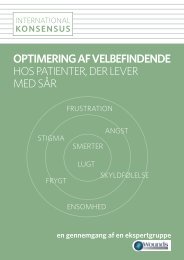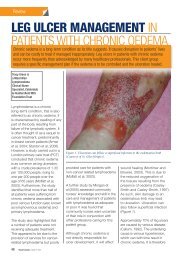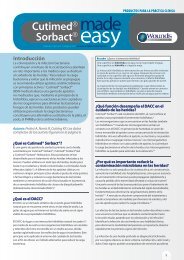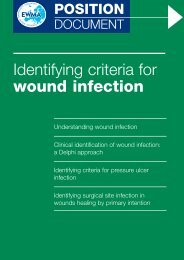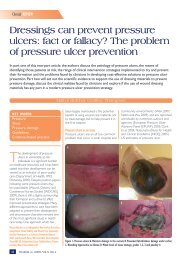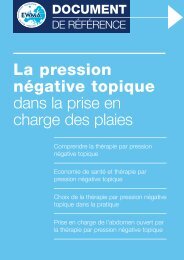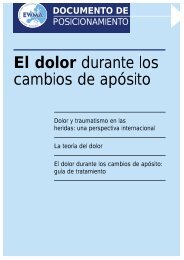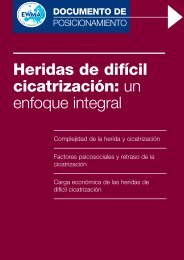best practice guidelines: wound management in diabetic foot ulcers
best practice guidelines: wound management in diabetic foot ulcers
best practice guidelines: wound management in diabetic foot ulcers
- No tags were found...
You also want an ePaper? Increase the reach of your titles
YUMPU automatically turns print PDFs into web optimized ePapers that Google loves.
DFU WOUNDMANAGEMENTHydrosurgical debridement This is an alternativemethod of <strong>wound</strong> debridement, whichforces water or sal<strong>in</strong>e <strong>in</strong>to a nozzle to createa high-energy cutt<strong>in</strong>g beam. This enablesprecise visualisation and removal of devitalisedtissue <strong>in</strong> the <strong>wound</strong> bed 77 .Autolytic debridement This is a naturalprocess that uses a moist <strong>wound</strong> dress<strong>in</strong>gto soften and remove devitalised tissue.Care must be taken not to use a moisturedonat<strong>in</strong>gdress<strong>in</strong>g as this can predispose tomaceration. In addition, the application ofmoisture-retentive dress<strong>in</strong>gs <strong>in</strong> the presenceof ischaemia and/or dry gangrene is notrecommended 38,76 .Not debrid<strong>in</strong>g a <strong>wound</strong>, not referr<strong>in</strong>g apatient to specialist staff for debridement, orchoos<strong>in</strong>g the wrong method of debridement,can cause rapid deterioration with potentiallydevastat<strong>in</strong>g consequences.Inflammation and <strong>in</strong>fection controlThe high morbidity and mortality associatedwith <strong>in</strong>fection <strong>in</strong> DFUs means that earlyand aggressive treatment — <strong>in</strong> the presenceof even subtle signs of <strong>in</strong>fection — is moreappropriate than for <strong>wound</strong>s of otheraetiologies (with the exception of immunocompromisedpatients) (Table 4, page12) 38 . In one study, nearly half of patientsadmitted to a specialised <strong>foot</strong> cl<strong>in</strong>ic <strong>in</strong>France with a <strong>diabetic</strong> <strong>foot</strong> <strong>in</strong>fection wenton to have a lower-limb amputation 78 .Both the IDSA 46 and the InternationalDiabetes Federation (IDF) recommendclassify<strong>in</strong>g <strong>in</strong>fected DFUs by severity andus<strong>in</strong>g this to direct appropriate antibiotictherapy 27 . Cl<strong>in</strong>ically un<strong>in</strong>fected <strong>wound</strong>sshould not be treated with systemic antibiotictherapy. However, virtually all <strong>in</strong>fected<strong>wound</strong>s require antibiotic therapy 46 .Superficial DFUs with sk<strong>in</strong> <strong>in</strong>fection (mild<strong>in</strong>fection)For mild <strong>in</strong>fections <strong>in</strong> patients who have notrecently received antibiotic treatment 7,46 : Start empiric oral antibiotic therapy targetedat Staphylococcus aureus andß-haemolytic Streptococcus Change to an alternate antibiotic if theculture results <strong>in</strong>dicate a more appropriateantibiotic Obta<strong>in</strong> another optimum specimen forculture if the <strong>wound</strong> does not respond totreatment.Role of topical antimicrobials The <strong>in</strong>creas<strong>in</strong>gprevalence of antimicrobial resistance(eg meticill<strong>in</strong>-resistant S. aureus [MRSA]) orother complications (eg Clostridium difficile<strong>in</strong>fection) has led to a rise <strong>in</strong> the use oftopical antimicrobial treatments for<strong>in</strong>creased <strong>wound</strong> bioburden 79 (Box 3).Antimicrobial agents that are used topicallyhave the advantage of not driv<strong>in</strong>g resistance.Such agents provide high local concentrations,but do not penetrate <strong>in</strong>tact sk<strong>in</strong> or <strong>in</strong>todeeper soft tissue 80 .Topical antimicrobials may be beneficial <strong>in</strong>certa<strong>in</strong> situations 79 : Where there are concerns regard<strong>in</strong>greduced antibiotic tissue penetration —for example, where the patient has a poorvascular supply In non-heal<strong>in</strong>g <strong>wound</strong>s where the classicsigns and symptoms of <strong>in</strong>fection are absent,but where there is a cl<strong>in</strong>ical suspicionof <strong>in</strong>creased bacterial bioburden.In these situations topical antimicrobials(either alone or as an adjunctive therapyto systemic therapy) have the potential toreduce bacterial load and may protect the<strong>wound</strong> from further contam<strong>in</strong>ation 79 . In addition,treatment at an early stage may preventspread of <strong>in</strong>fection to deeper tissues 82 .An <strong>in</strong>itial two-week period with regularreview is recommended for the use of topicalantimicrobials <strong>in</strong> <strong>wound</strong>s that are mildly<strong>in</strong>fected or heavily colonised. A recentconsensus offers recommendations on appropriateuse of silver dress<strong>in</strong>gs 83 . If aftertwo weeks: There is improvement <strong>in</strong> the <strong>wound</strong>, butcont<strong>in</strong>u<strong>in</strong>g signs of <strong>in</strong>fection, it may becl<strong>in</strong>ically justifiable to cont<strong>in</strong>ue the chosentreatment with further regular reviews The <strong>wound</strong> has improved and the signsand symptoms of <strong>wound</strong> <strong>in</strong>fection are nolonger present, the antimicrobial shouldbe discont<strong>in</strong>ued and a non-antimicrobialdress<strong>in</strong>g applied to cover the open <strong>wound</strong> There is no improvement, consider discont<strong>in</strong>u<strong>in</strong>gthe antimicrobial treatmentand re-cultur<strong>in</strong>g the <strong>wound</strong> and reassess<strong>in</strong>gthe need for surgical therapy orrevascularisation.BOX 3: Common topicalantimicrobial agents thatmay be considered for useas an adjunctive therapy for<strong>diabetic</strong> <strong>foot</strong> <strong>in</strong>fections* Silver — dress<strong>in</strong>gs conta<strong>in</strong><strong>in</strong>gsilver (elemental,<strong>in</strong>organic compound ororganic complex) or silversulphadiaz<strong>in</strong>e cream/dress<strong>in</strong>gs Polyhexamethylenebiguanide (PHMB) —solution, gel or impregnateddress<strong>in</strong>gs Iod<strong>in</strong>e — povidone iod<strong>in</strong>e(impregnated dress<strong>in</strong>g) orcadexomer iod<strong>in</strong>e (o<strong>in</strong>tment,beads or impregnateddress<strong>in</strong>gs) Medical-grade honey —gel, o<strong>in</strong>tment or impregnateddress<strong>in</strong>gs*NB: Topical antimicrobialagents should not be usedalone <strong>in</strong> those with cl<strong>in</strong>icalsigns of <strong>in</strong>fectionBEST PRACTICE GUIDELINES: WOUND MANAGEMENT IN DIABETIC FOOT ULCERS 11




